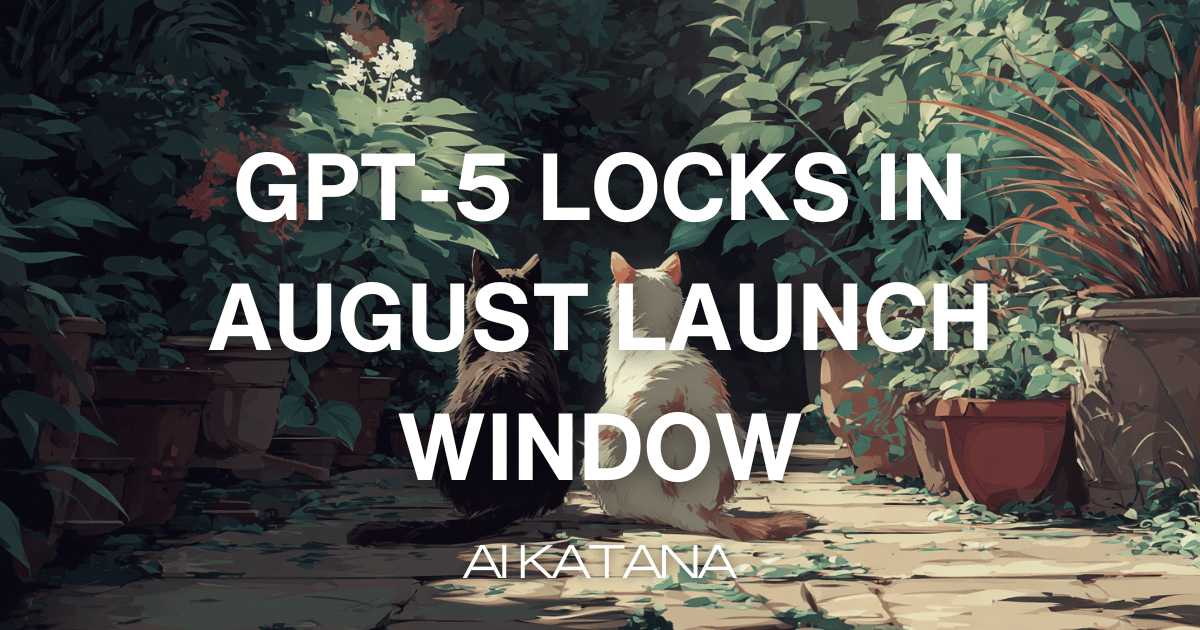- AI KATANA
- Posts
- GPT-5 Locks in August Launch Window
GPT-5 Locks in August Launch Window
Also: Alphabet commits record $85B to AI capex

Hello!
Over the last 24 hours AI headlines have spanned blockbuster product reveals, record-setting capital bets and eye-catching regional initiatives. OpenAI has quietly firmed up an early-August debut for GPT-5, setting the stage for a fresh benchmark war just as Alphabet confirms it will pour an unprecedented $85 billion into AI infrastructure this year. Meanwhile, a PwC forecast says AI-directed advertising will shoulder most of the entertainment industry’s future growth, and booming demand for banned Nvidia accelerators has spawned a cottage repair economy inside China. Singapore is moving to triple its specialist talent pool beyond 15 000 practitioners, and Israeli chip-vision pioneer Mobileye just hiked guidance on the back of resurgent autonomous-driving orders. Sprinkle in Google’s new AI-curated “Web Guide,” fresh ChatGPT connectors, large medical and video-analytics fund-raises, and Elon Musk’s plan to resurrect Vine with generative clips, and there’s no shortage of momentum—or drama—to unpack.
Sliced just for you:
🧠 GPT-5 locks in August launch window
📊 PwC: AI ads set to dominate media growth
🔧 China scrambles to patch banned Nvidia chips
💸 Alphabet commits record $85B to AI capex
🏫 Singapore widens its National AI talent pipeline
🚗 Mobileye lifts outlook on ADAS chip surge
Sources tell The Verge that OpenAI’s next flagship model, GPT-5, will roll out as early as the first week of August. Rather than one monolithic network, GPT-5 will stitch together multiple specialised sub-models—including the reasoning-centric o3 lineage—allowing the system to route tasks to whichever component is most efficient. Internal demos reportedly show sharper long-context comprehension and a “nano” variant designed for fully local inference on premium smartphones. Analysts expect the release to spark fresh enterprise upgrade cycles just as licensing talks with Apple, Salesforce and SAP enter final stages. OpenAI declined comment, but staff have been briefed on a tiered launch across ChatGPT and the public API.
PwC’s new Global Entertainment & Media Outlook projects the sector will balloon to $3.5 trillion by 2029, with AI-powered advertising emerging as the chief growth engine. Digital formats are forecast to rise from 72 % of total ad spend in 2024 to 80 % by 2029, and connected-TV slots alone should clear $51 billion. Consultants say generative copy, dynamic placement and real-time creative optimisation will compensate for sluggish subscriber spending in film, music and news. The report urges studios to invest in AI tooling and first-party data to avoid ceding margins to ad-tech intermediaries. It also flags rising regulatory scrutiny around synthetic content but concludes that personalised, AI-served ads will be “the industry’s default business model” within four years.
With U.S. export curbs limiting fresh supply, Chinese cloud firms and gray-market brokers are flooding repair shops to refurbish damaged A100, H100 and H20 accelerators. Technicians in Shenzhen report month-on-month demand up 300 %, while prices for working boards have climbed above official list levels. Some vendors are even “parting out” dead cards to harvest scarce HBM stacks. Analysts say the boom exposes China’s reliance on U.S. silicon and could extend model-training timelines by up to six months, but it also nurtures a domestic ecosystem of diagnostic talent that may accelerate home-grown GPU design.
Alphabet’s latest earnings call revealed an eye-popping decision to lift 2025 capital expenditure to $85 billion—20% of projected sales and 60% above last year. The bulk goes to GPU-dense data-centres, renewable-energy PPAs and fourth-generation Tensor Processing Units aimed at slashing inference costs. Despite cash-flow compression, management insists scale is essential to defend search, YouTube and Cloud margins against agentic rivals. Investors appeared convinced: shares ticked higher on 14% topline growth and a 19 % jump in net income, even as regulators circle over antitrust concerns.
Singapore’s government is expanding its AI Strategy 2.0 target, now aiming to train lawyers, doctors and other professionals alongside engineers to push the practitioner base well beyond the original 15 000-person goal. New conversion courses, mid-career fellowships and sector-specific sandboxes will launch over the next 18 months, with priority given to healthcare, legal tech and maritime logistics. Officials argue that embedding domain experts in AI teams will speed trustworthy adoption and help the city-state punch above its weight in the regional AI economy.
Autonomous-driving specialist Mobileye has raised its 2025 revenue outlook to as high as $1.89 billion after carmakers cleared inventory logjams and resumed ordering its EyeQ™ chips. Management cited a “clear inflection” in Level-2+ ADAS demand and expects a bigger revenue jolt in 2027 when next-gen silicon hits production. Shares jumped about 6 % in pre-market trading, underscoring confidence that the safety-oriented AI stack is becoming core to automakers’ road-maps despite tariff noise and supply-chain cost pressures.
🛠️ AI tools updates
Google’s new Labs feature overhauls classic “10 blue links” by clustering results under AI-generated topic headings, delivering context-rich categories like “Troubleshooting Mango Tree Issues” alongside traditional links. Running on a stripped-down Gemini variant, Web Guide appears in the “Web” tab for opt-in users and balances generative summaries with source diversity—an attempt to quell publisher backlash over SGE snippets. Roll-out to the default “All” tab is planned if feedback is positive.
OpenAI’s latest release notes introduce native connectors that let ChatGPT fetch, search and summarise assets stored in Canva or Notion workspaces—extending a growing list that already includes Google Drive and HubSpot. The integrations support both chat search and deep-research workflows, though they’re currently unavailable inside the EEA and UK due to data-transfer rules. Power users can also build custom connectors via Model Context Protocol to tie LLMs into proprietary systems.
💵 Venture Capital updates
Diagnostic-imaging vendor Aidoc secured $150 million in fresh capital—plus a $40 million credit line—from General Catalyst, Square Peg and NVentures. The money funds “CARE,” a multimodal foundation model that underpins FDA-cleared tools for rib-fracture and aortic-dissection detection. Aidoc plans to shift its 150-hospital install base to the new model and expand aiOS, its deployment layer for third-party algorithms. Total funding now tops $370 million.
Long-context video analytics startup Memories.ai closed an oversubscribed $8 million seed round with Samsung Next, Susa Ventures and others. The platform indexes up to 10 million hours of footage, letting marketers and security firms query events across sprawling archives by natural language. Founders—alumni of Meta Reality Labs—say on-device processing will enable privacy-preserving consumer features down the line. Funds will scale the 15-person team and refine compression and indexing layers ahead of a planned Series A.
🫡 Meme of the day

⭐️ Generative AI image of the day

Before you go, Vine to Return in “AI Form,” Says Musk.
